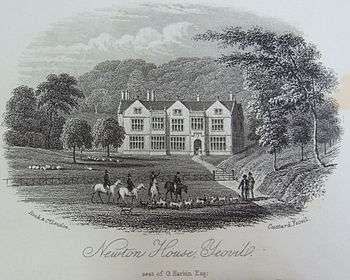Newton Surmaville
| Newton Surmaville | |
|---|---|
| General information | |
| Town or city | Yeovil |
| Country | England |
| Construction started | 1608 |
| Completed | 1612 |
| Client | Robert Harbin |
| Website | |
| www.newtonsurmaville.co.uk | |
Newton Surmaville is a small park and house south of Yeovil, Somerset in the district of South Somerset, in England. It lies just outside the town in the parish of Barwick.
House

The house, which is also known as Newton House, was built between 1608 and 1612, on the site of an earlier building, but was extensively altered and enhanced in the 1870s. It was built for Robert Harbin, a Yeovil merchant. The house still contained much of its original furniture and an eclectic library of many thousands of volumes. There were also 17th-century tapestries, portraying scenes of "Elijah Rising into Heaven and the Melting of the Golden Calf" in sculpted gold frames, and collections of antique pewter and pistols and swords.[1] Some of the contents were given to the Museum of Somerset, the Somerset Military Museum and auctioned at Sothebys in London.[2]
It has been designated by English Heritage as a Grade I listed building.[3] The Surmaville part of the name comes from the de Salmonville family.[1]
There are various outbuildings including the stables,[4] gardeners cottage,[5] and barn.[6]
Grounds
The gardens and pleasure grounds cover around two hectares, and slope down to the River Yeo. They were laid out in the mid 18th century, with further landscaping in the 19th. The pleasure gardens included five ponds, a boathouse, a curving lime avenue canter, a walled kitchen garden, a rose garden and herbaceous borders to the east of the pond accessed via circa 1700 gates. The summerhouse dates from 1750, and was built as a 3-storey octagon with 2-storey flanking wings. It has since been converted into a cottage.[7] The original design of the grounds is described in the memoirs "The Revd George Harbin and his memoirs of gardening 1716-1723".[8] The grounds are listed, Grade II, on the Register of Historic Parks and Gardens of special historic interest in England.[9]
Further reading
- Anon, 1906, Yeovil With Its Surroundings The Homeland Handbook Series
- Bates Harbin, E. H., 1910, "History of the Manor of Newton Surmaville" Proceedings of the Somersetshire Archaeological and Natural History Society Vol 56 (Third Series, 16), Part II, 1-30
- Beet, Toni, 2004, Yeovil — a history and celebration of the town Ottakar’s/Francis Frith
- Darling-Finan, Nicola, 2001, Yeovil: A Photographic History of Your Town W. H. Smith/Francis Frith
- Dunning, Robert, 1991, Some Country Houses: A Personal Selection Wimborne: Dovecot Press
- Garner, Thomas and Stratton, Arthur, 1929, The Domestic Architecture of England During the Tudor Period London: B T Batsford Ltd, 2nd edition, revised and enlarged.
- Gerrard, James, 1995, "The Summer House of the Newton Surmaville Estate" Chronicle (the journal of Yeovil Archaeological and Local History Society), Vol 6, No 5, October 1995, 109-111
- Murray, Stephen, 1941, Yeovil, Sherborne and the West Country with a Journey along the Fosse Way to the North Yeovil: Stephen Murray and Co. Ltd.,/The Viking Press
- Nares, Gordon, 1952, "Newton Surmaville, Somerset — I. The Home of Mrs Bates Harbin" Country Life 5 September 1952, 676-69
- Nares, Gordon, 1952, "Newton Surmaville, Somerset — II. The Home of Mrs Bates Harbin" Country Life 12 September 1952, 760-763
- Nares, Gordon, 1952, "Newton Surmaville, Somerset — III. The Home of Mrs Bates Harbin" Country Life 19 September 1952, 844-847
- Nash, Judy, 1993, "Newton Surmaville" The Somerset Magazine September 1993, 47-49
- Pevsner, Nikolaus, 1958, South and West Somerset London: Penguin The Buildings of England series
- Rawlins, Sophia W., 1965, "Newton Surmaville" Proceedings of the Somersetshire Archaeological and Natural History Society for 1964/5, Vol 109, 30-35
- Vickery, Daniel, 1856, A Sketch of the Town of Yeovil
References
- 1 2 "Genuine Somerset — Newton Surmaville is untouched by the 20th century". Times Online. London. 20 April 2007. Retrieved 26 September 2007.
- ↑ "The aristocratic house clearance". Bournemouth Daily Echo. Retrieved 5 Nov 2015.
- ↑ "Newton Surmaville". Images of England. Retrieved 25 September 2007.
- ↑ "The former stables, 100 metres south of Newton House". Images of England. Retrieved 25 September 2007.
- ↑ "The Gardener's Cottage, 90 metres south of Newton House". Images of England. Retrieved 25 September 2007.
- ↑ "Barn, 40 metres south of Newton Farmhouse". Images of England. Retrieved 25 September 2007.
- ↑ "Newton Surmaville Park, Newton Surmaville". Somerset Historic Environment Record. Retrieved 26 September 2007.
- ↑ Michael, McGarvie; Harvey, John H. (1983). "The Revd George Harbin and his memoirs of gardening 1716-1723". Garden History. Garden History, Vol. 11, No. 1. 11 (1): 6–36. doi:10.2307/1586769. JSTOR 1586769.
- ↑ "Newton Surmaville". National Heritage List for England. Historic England. Retrieved 9 February 2016.
Coordinates: 50°56′05″N 2°37′00″W / 50.93472°N 2.61667°W